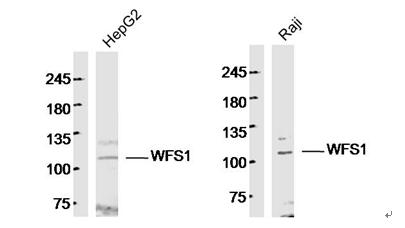
Rabbit Anti-WFS1 antibody
DFNA14; DFNA38; DFNA6; DIDMOAD; WFRS; WFS; Wolfram syndrome 1 (wolframin); Wolfram syndrome; WOLFRAMIN; WFS1_HUMAN.
View History [Clear]
Details
Product Name WFS1 Chinese Name Wolfram综合征蛋白1抗体 Alias DFNA14; DFNA38; DFNA6; DIDMOAD; WFRS; WFS; Wolfram syndrome 1 (wolframin); Wolfram syndrome; WOLFRAMIN; WFS1_HUMAN. Research Area Tumour Neurobiology Signal transduction Growth factors and hormones Diabetes The new supersedes the old Immunogen Species Rabbit Clonality Polyclonal React Species Human, (predicted: Mouse, Rat, Dog, Cow, Horse, ) Applications WB=1:500-2000 ELISA=1:5000-10000 IHC-P=1:100-500 IHC-F=1:100-500 ICC=1:100-500 IF=1:100-500 (Paraffin sections need antigen repair)
not yet tested in other applications.
optimal dilutions/concentrations should be determined by the end user.Theoretical molecular weight 97kDa Cellular localization cytoplasmic The cell membrane Form Liquid Concentration 1mg/ml immunogen KLH conjugated synthetic peptide derived from human WFS1: 791-890/890 Lsotype IgG Purification affinity purified by Protein A Buffer Solution 0.01M TBS(pH7.4) with 1% BSA, 0.03% Proclin300 and 50% Glycerol. Storage Shipped at 4℃. Store at -20 °C for one year. Avoid repeated freeze/thaw cycles. Attention This product as supplied is intended for research use only, not for use in human, therapeutic or diagnostic applications. PubMed PubMed Product Detail Wolfram syndrome protein (WFS1) is an 890 amino acid protein that contains a cytoplasmic N-terminal domain, followed by nine-transmembrane domains and a luminal C-terminal domain. WFS1 is predominantly localized to the endoplasmic reticulum (ER) (1) and its expression is induced in response to ER stress, partially through transcriptional activation (2,3). Research studies have shown that mutations in the WFS1 gene lead to Wolfram syndrome, an autosomal recessive neurodegenerative disorder defined by young-onset, non-immune, insulin-dependent diabetes mellitus and progressive optic atrophy (4).
Function:
WFS1 is a novel component of Wolfram syndrome, a rare form of juvenile diabetes. WFS1 plays an important role in maintaining homeostasis of the endoplasmic reticulum (ER) in the pancreas. It is normally up-regulated during insulin secretion, whereas inactivation of the protein can cause ER stress. Chronic ER stress is a major involvement in Wolfram syndrome.
Subcellular Location:
Endoplasmic reticulum; endoplasmic reticulum membrane; multipass membrane protein
Tissue Specificity:
Highly expressed in heart followed by brain, placenta, lung and pancreas. Weakly expressed in liver, kidney and skeletal muscle. Also expressed in islet and beta-cell insulinoma cell line.
DISEASE:
Defects in WFS1 are the cause of Wolfram syndrome type 1 (WFS1) [MIM:222300]. A rare autosomal recessive disorder characterized by juvenile diabetes mellitus, diabetes insipidus, optic atrophy, deafness and various neurological symptoms.
Defects in WFS1 are the cause of deafness autosomal dominant type 6 (DFNA6) [MIM:600965]; also called non-syndromic sensorineural deafness autosomal dominant type 14 (DFNA14) or non-syndromic sensorineural deafness autosomal dominant type 38 (DFNA38). DFNA6 is a form of sensorineural hearing loss. Sensorineural deafness results from damage to the neural receptors of the inner ear, the nerve pathways to the brain, or the area of the brain that receives sound information. DFNA6 is a low-frequency hearing loss in which frequencies of 2000 Hz and below are predominantly affected. Many patients have tinnitus, but there are otherwise no associated features such as vertigo. Because high-frequency hearing is generally preserved, patients retain excellent understanding of speech, although presbycusis or noise exposure may cause high-frequency loss later in life. DFNA6 worsens over time without progressing to profound deafness.
Defects in WFS1 are the cause of Wolfram-like syndrome autosomal dominant (WFSL) [MIM:614296]. A disease characterized by the clinical triad of congenital progressive hearing impairment, diabetes mellitus, and optic atrophy. The hearing impairment, which is usually diagnosed in the first decade of life, is relatively constant and alters mainly low- and middle-frequency ranges.
SWISS:
O76024
Gene ID:
7466
Database links:Entrez Gene: 7466 Human
Entrez Gene: 22393 Mouse
Omim: 606201 Human
SwissProt: O76024 Human
SwissProt: P56695 Mouse
Unigene: 518602 Human
Unigene: 20916 Mouse
Unigene: 229139 Rat
Product Picture
Bought notes(bought amounts latest0)
No one bought this product
User Comment(Total0User Comment Num)
- No comment



 +86 571 56623320
+86 571 56623320
 +86 18668110335
+86 18668110335

